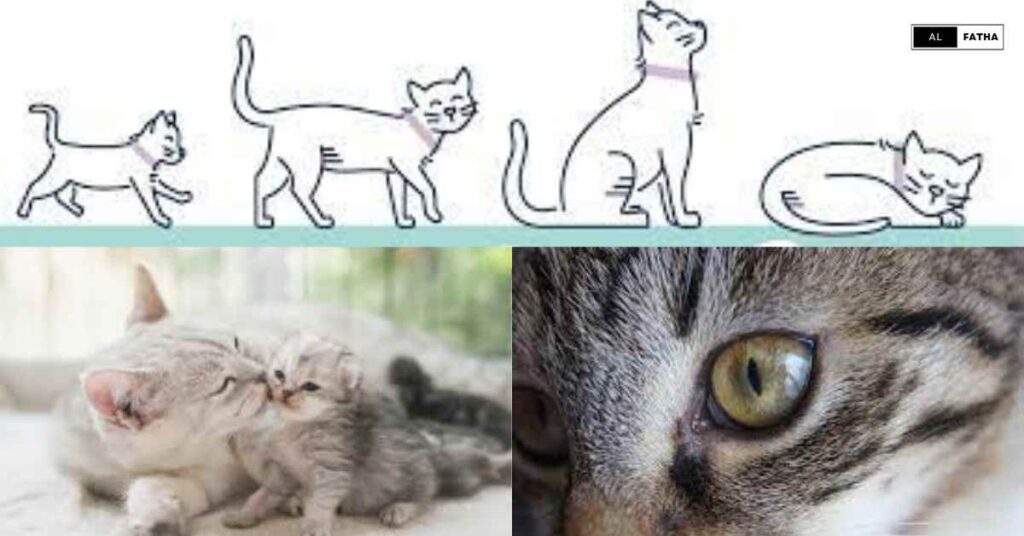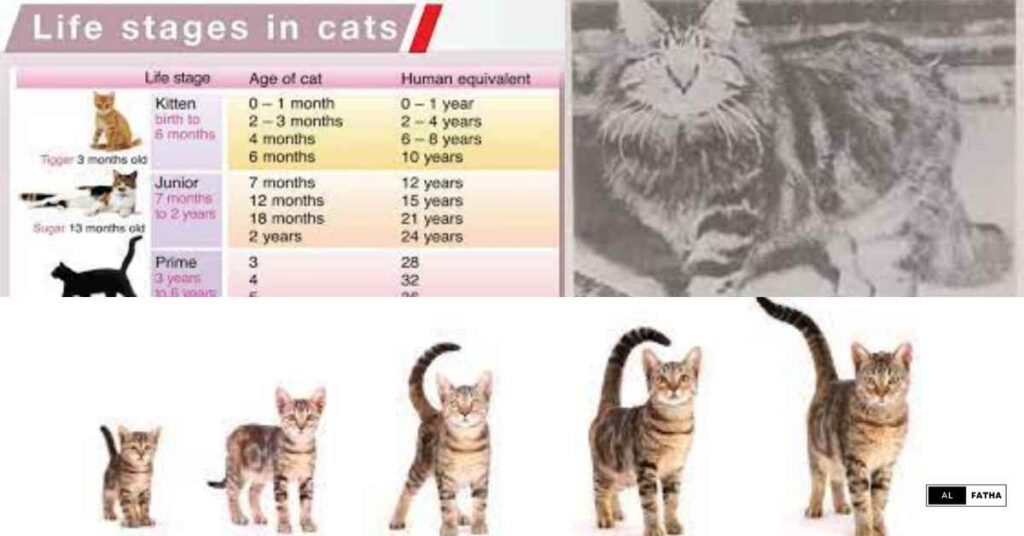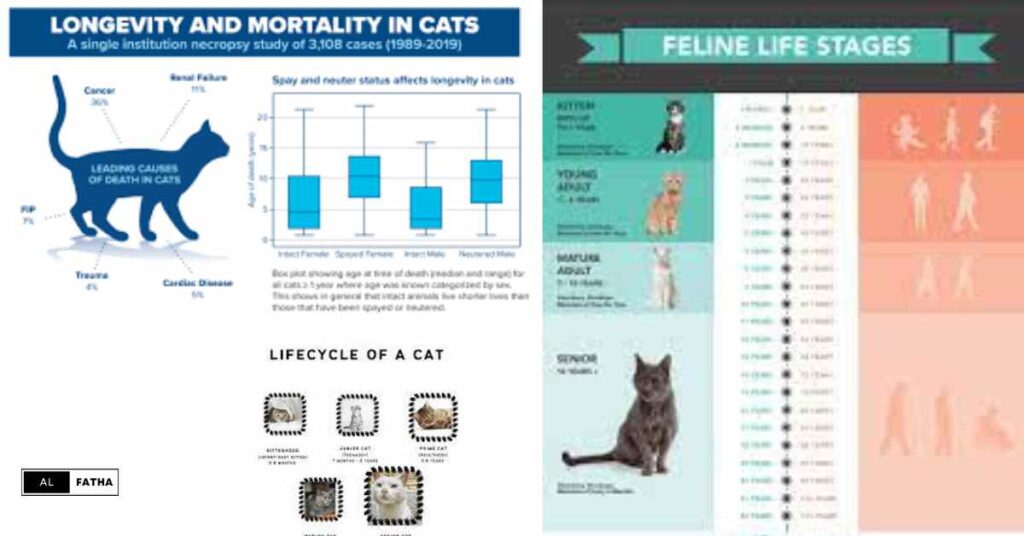How Long Do Cats Live? Demystifying the Mystique of Cat Lifespan
Table of Contents
1. Introduction:
Curious about your feline friend’s lifespan? The longevity of a cat is a multifaceted puzzle, influenced by various factors. In this article, we unveil the secrets to understanding “How Long Do Cats Live?”
From assessing different life stages to exploring the average lifespan, we delve into the nuances that determine your cat’s journey through the years. Whether you’re a cat owner or contemplating feline companionship, join us as we unravel the mysteries behind a cat’s enduring life.
2. Assessing Cat Age
Understanding your cat’s age is crucial for providing tailored care at every life stage. Cats go through distinct phases, each requiring specific attention and considerations.
Life Stages:
Kitten (Up to Six Months):
- Rapid growth and development
- Specialized nutrition needs
- Introduction to litter training and socialization
Junior (Six Months – Two Years):
- Transition to adulthood
- Energy levels peak
- Sexual maturity considerations, such as spaying/neutering
Prime (Three – Six Years):
- Peak of physical health
- Established routines and behaviors
- Attention to dental care and regular vet check-ups
Mature (Seven – 10 Years):
- Gradual slowing down
- Dietary adjustments for aging
- Monitoring for signs of health issues
Senior (11 – 14 Years):
- Increased vulnerability to age-related conditions
- Specialized senior diets and regular vet visits
- Comfortable living environment modifications
Geriatric (15 Years and Older):
- Focus on quality of life
- Regular vet assessments for age-related ailments
- Adjustments to diet, exercise, and overall care
How to Determine a Cat's Age:
Teeth Examination:
- Kittens have sharp, small teeth, while older cats may have wear and tear.
Coat and Eyes:
- Kittens typically have softer fur and bright eyes; aging cats may develop graying fur and cloudy eyes.
Behavioral Cues:
- Playfulness and curiosity are prominent in kittens, while older cats may exhibit more relaxed behaviors.
Understanding these life stages and age indicators allows you to provide targeted care, ensuring your cat’s well-being at every step. Stay tuned as we delve deeper into the average lifespan of cats and unveil more insights into feline longevity.
3. Average Cat Lifespan

Cats, like humans, have a lifespan influenced by various factors. Delving into the general statistics and understanding the nuances of a cat’s lifespan provides valuable insights for cat owners.
General Lifespan Statistics:
Average Lifespan:
- Domestic cats generally live between 12 to 15 years.
- With proper care, some cats surpass 20 years.
Factors Affecting Lifespan:
- Genetics: Breeds may have predispositions to certain health issues.
- Diet: A well-balanced, nutritious diet contributes to overall health.
- Healthcare: Regular veterinary check-ups and preventive care enhance lifespan.
- Environment: Indoor cats often live longer due to reduced exposure to risks.
Indoor vs. Outdoor Cat Life Expectancy:
Indoor Cats:
- Generally, indoor cats live longer, with some reaching 18 years or more.
- Reduced exposure to accidents, predators, and diseases increases lifespan.
Outdoor Cats:
- Outdoor cats face more risks, resulting in a shorter average lifespan of 5 to 10 years.
- Accidents, fights with other animals, and disease transmission contribute to a shorter life expectancy.
Insights into Cat Lifespan:
Quality of Life:
- Providing a stimulating environment enhances a cat’s mental and physical well-being.
- Enrichment activities and proper healthcare contribute to a longer, happier life.
Cats with Special Needs:
- Cats with specific health conditions may have varying lifespans.
- Adapting care to individual needs ensures a fulfilling life.
As we explore further, we’ll uncover the life stages of cats, providing a comprehensive understanding of how to optimize your cat’s longevity. Stay tuned for insights into fostering a thriving, healthy feline companion.
4. Life Stages of Cats


Cats progress through distinct life stages, each presenting unique characteristics and care requirements. Understanding these phases is essential for providing optimal support and ensuring a cat’s well-being throughout its life.
Kitten (Birth to 1 Year):
Rapid Growth and Development:
- Kittens undergo significant physical and behavioral changes.
- Frequent meals, rich in nutrients, support their growth.
Socialization and Training:
- Introduction to litter training and socializing with humans and other animals.
- Play is crucial for developing coordination and social skills.
Young Adult (1-6 Years):
Transition to Adulthood:
- Sexual maturity occurs, necessitating spaying or neutering.
- Energy levels peak, requiring ample play and exercise.
Established Routines:
- Cats develop specific behaviors and preferences.
- Consistent feeding schedules and routines contribute to stability.
Mature Adult (6-10 Years):
Physical Peak:
- Peak of physical health and agility.
- Continued dental care is crucial for long-term health.
Behavioral Stability:
- Behavior becomes more consistent.
- Attention to weight management and preventive healthcare.
Senior (10+ Years):
Increased Vulnerability:
- Susceptibility to age-related conditions such as arthritis or dental issues.
- Specialized senior diets and regular veterinary check-ups.
Comfort Modifications:
- Creating a comfortable environment with easily accessible resources.
- Monitoring for signs of cognitive decline or discomfort.
Geriatric (15 Years and Older):
Focus on Quality of Life:
- Prioritizing comfort, mental stimulation, and a balanced diet.
- Regular vet assessments for early detection of health issues.
Adapting to Changing Needs:
- Adjusting care as mobility decreases or specific health conditions arise.
- Ensuring a peaceful and loving environment in the twilight years.
Understanding and adapting to these life stages ensures that your cat receives appropriate care at each phase. In the next section, we’ll delve into strategies for improving your cat’s overall lifespan and well-being. Stay tuned for valuable insights into fostering a thriving, long-lived feline companion.
5. Cats' Lifecycle and Longevity


The lifespan of domestic cats has evolved over time, influenced by factors ranging from genetics to advancements in veterinary care. Exploring the historical context and modern-day considerations sheds light on the secrets to feline longevity.
Evolution of Cat Lifespan:
Historical Perspectives:
- Domestication and cohabitation with humans influenced cat survival.
- Ancient cats faced challenges such as predation and limited healthcare.
Advancements in Veterinary Care:
- Modern veterinary treatments contribute to increased cat lifespans.
- Vaccinations, preventive medications, and surgical interventions enhance overall well-being.
Modern Longevity Trends:
Better Healthcare:
- Veterinary science has made significant strides, offering targeted treatments.
- Routine vaccinations and preventive measures reduce the impact of diseases.
Nutritional Advances:
- Specialized cat diets address specific life stage requirements.
- Balanced nutrition plays a pivotal role in promoting health and longevity.
Longest Living Cat Breeds:
Factors Influencing Breed Longevity:
- Genetic predispositions contribute to varying lifespans.
- Selective breeding practices impact the overall health of specific breeds.
Noteworthy Long-Lived Breeds:
- Some breeds, such as Siamese, Persians, and Russian Blues, are known for longer lifespans.
- Maintaining breed-specific health considerations ensures a higher quality of life.
Feline Longevity in the Modern Context:
Individual Cat Variability:
- Each cat is unique, and factors such as genetics and early care influence longevity.
- Recognizing and addressing individual needs is key to a cat’s well-being.
Quality of Life Considerations:
- Beyond years lived, focusing on the cat’s overall quality of life is paramount.
- Mental stimulation, proper care, and a loving environment contribute to happiness.
As we explore strategies for enhancing your cat’s lifespan in the next section, keep in mind the historical context and the current factors shaping feline longevity. Join us in unraveling the secrets to fostering a healthy, happy, and long-lived feline companion.
6. Improving Cat Lifespan


Ensuring a longer, healthier life for your cat involves a combination of attentive care, proper nutrition, and understanding their unique needs at every stage. Let’s explore practical strategies to optimize your feline companion’s lifespan.
Tips for Increasing Life Expectancy:
Balanced Nutrition:
- Provide a high-quality, age-appropriate diet to meet your cat’s nutritional requirements.
- Consult with your vet to address specific dietary needs, especially in senior cats.
Regular Veterinary Check-ups:
- Schedule routine check-ups to monitor your cat’s health and detect potential issues early.
- Vaccinations, parasite prevention, and dental care contribute to overall well-being.
Exercise and Mental Stimulation:
- Encourage physical activity through interactive play and the provision of stimulating toys.
- Mental engagement, such as puzzle feeders, supports cognitive health.
Weight Management:
- Sustain a healthy weight to avoid problems associated with obesity.
- Adjust feeding portions based on age, activity level, and any health considerations.
Proper Care for Different Life Stages:
Kittens:
- Follow vaccination schedules and ensure a safe, stimulating environment.
- Gradually introduce grooming practices for future comfort.
Adults:
- Monitor weight and adjust diet accordingly.
- Provide scratching posts and outlets for natural behaviors.
Seniors:
- Adapt the home environment for ease of movement.
- Consider senior-specific diets and regular health assessments.
Recognizing Signs of Aging:
Behavioral Changes:
- Pay attention to alterations in activity levels, grooming habits, or litter box usage.
- Increased vocalization or changes in social behavior may indicate underlying issues.
Dental Care:
- Dental problems are common in older cats; address them promptly to avoid discomfort.
- Brushing your cat’s teeth or incorporating dental treats can support oral health.
Personalized Care:
Understanding Individual Needs:
- Cats have unique personalities and health requirements.
- Tailor care based on your cat’s preferences, health history, and comfort.
Quality of Life Focus:
- Prioritize creating a stress-free, loving environment.
- Foster a strong bond through regular positive interactions.
By implementing these strategies, you not only contribute to your cat’s longevity but also enhance their overall quality of life. In the next section, we’ll delve into specific considerations for indoor and outdoor living, shedding light on factors that impact your cat’s lifespan. Stay tuned for more insights into fostering a thriving, long-lived feline companion.
7. Specific Considerations


Understanding the specific considerations of indoor and outdoor living, exploring the life expectancies of different cat breeds, and debunking common misconceptions are key to providing optimal care for your feline companion.
Indoor vs. Outdoor Living:
Indoor Cats:
Pros:
- Reduced exposure to external dangers like predators and traffic.
- Lower risk of infectious diseases.
- Controlled environment for safety and comfort.
Cons:
- Limited space for physical activity.
- Potential for obesity without proper exercise.
- Need for mental stimulation through toys and interactive play.
Outdoor Cats:
Pros:
- More space for physical activity and exploration.
- Natural behaviors like hunting and climbing.
- Sunlight exposure for vitamin D synthesis.
Cons:
- Increased risk of accidents, injuries, and fights.
- Exposure to infectious diseases and parasites.
- Shorter average lifespan due to external risks.
Different Cat Breeds and Life Expectancies:
Genetic Influences:
- Breeds may have predispositions to certain health issues.
- Selective breeding practices impact overall health and longevity.
Noteworthy Long-Lived Breeds:
- Siamese: Known for an average lifespan of 15-20 years.
- Persians: Average lifespan ranges from 12-16 years.
- Russian Blues: May live 15 years or more.
Addressing Common Misconceptions:
Cats Have Nine Lives:
- Mythical notion; cats have one life, and their longevity depends on care.
Cats Age Seven Years for Every Human Year:
- Oversimplified; aging varies based on factors like breed and health.
Indoor Cats Don't Need Vet Visits:
- False; regular check-ups are essential for indoor cats to detect issues early.
Tailoring Care to Individual Needs:
Personalized Healthcare:
- Consult with your vet to create a tailored healthcare plan.
- Consider factors like breed, age, and any pre-existing conditions.
Environmental Adaptations:
- Adjust the living space based on your cat’s needs.
- Provide mental stimulation, regardless of indoor or outdoor living.
By addressing these specific considerations, you can make informed decisions to enhance your cat’s quality of life and contribute to their overall longevity. In the following section, we’ll delve into the role of veterinary care and support in ensuring your cat’s health and well-being. Stay tuned for insights into the comprehensive care measures that support a thriving, long-lived feline companion.
8. Veterinary Care and Support
The role of veterinary care in promoting the health and well-being of your cat cannot be overstated. Regular check-ups, preventive measures, and attentive support from veterinary professionals contribute significantly to ensuring a long and fulfilling life for your feline companion.
Routine Veterinary Check-ups:
Frequency:
- Schedule annual check-ups for adult cats and more frequent visits for kittens, seniors, or those with health issues.
- Early detection of potential problems is crucial for effective intervention.
Vaccinations:
- Observe the immunization schedule that your veterinarian has prescribed.
- Vaccines guard against common and often fatal illnesses.
Parasite Prevention:
- Treat for internal parasites, fleas, and ticks on a regular basis as preventive measures.
- Parasite infestations can lead to severe health issues if left untreated.
Total Wellness Plan:
Comprehensive Health Monitoring:
- Consider enrolling your cat in a total wellness plan offered by veterinary clinics.
- These plans often cover routine check-ups, vaccinations, and preventive treatments.
Dental Care:
- Preventing oral health problems requires routine dental cleanings and examinations.
- Dental problems can impact overall health and contribute to systemic diseases.
Signs of Aging and Specialized Care:
Cognitive Decline:
- Monitor for signs of aging, such as changes in behavior or disorientation.
- Specialized diets and medications can support cognitive health.
Arthritis and Mobility Issues:
- Aging cats may experience arthritis; seek veterinary advice for pain management.
- Provide comfortable bedding and adjust the environment for ease of movement.
The Importance of Regular Vet Check-ups:
Early Detection of Health Issues:
- Regular vet visits facilitate early identification and intervention for health concerns.
- Blood tests and diagnostic screenings are valuable tools in assessing overall health.
Tailored Health Plans:
- Vets can create personalized health plans based on your cat’s age, breed, and individual health needs.
- Addressing specific concerns enhances the overall quality of life.
Support from Veterinary Professionals:
Consultation and Advice:
- Regular communication with your vet ensures continuous support.
- Seek guidance on nutrition, behavior, and any concerns you may have.
Emergency Preparedness:
- Be aware of emergency veterinary services in your area.
- Prompt action during emergencies can be crucial for a positive outcome.
By prioritizing regular veterinary care and seeking support when needed, you play a pivotal role in maintaining your cat’s health. In the next section, we’ll explore common myths and misconceptions surrounding cats’ health and longevity, providing clarity on essential aspects of feline care. Stay tuned for insights into debunking myths and fostering a robust healthcare routine for your feline companion.
9. Common Myths and Misconceptions


Dispelling myths and clarifying misconceptions is essential for providing accurate and effective care for your feline companion. Let’s explore and debunk some common myths surrounding cats’ health and longevity.
1. Cats Have Nine Lives:
- Reality: Cats have one life, just like any other living creature.
- Insight: This myth likely stems from cats’ agility and ability to survive accidents.
2. Cats Age Seven Years for Every Human Year:
- Reality: Aging in cats is more nuanced and varies based on factors like breed and health.
- Insight: The seven-year rule is an oversimplified approximation.
3. Indoor Cats Don't Need Vet Visits:
- Reality: Regular vet check-ups are crucial for indoor cats.
- Insight: Indoor cats can still develop health issues, and early detection is key.
4. Cats Always Land on Their Feet:
- Reality: While cats have a remarkable ability to right themselves during a fall, it’s not foolproof.
- Insight: Cats can still suffer injuries, and high falls can be dangerous.
5. Cats Should Drink Milk:
- Reality: Many adult cats are lactose intolerant.
- Insight: While kittens nurse, adult cats often lack the enzymes to digest lactose.
6. Cats Shouldn't Go to the Vet Unless Sick:
- Reality: Regular vet check-ups are preventive and help detect issues early.
- Insight: Waiting until a cat is visibly unwell may hinder timely intervention.
7. Cats Don't Need Dental Care:
- Reality: Dental care is crucial for overall health.
- Insight: Dental problems can lead to systemic issues; regular dental check-ups are essential.
8. Cats Only Need Dry Food:
- Reality: A balanced diet includes wet and dry food options.
- Insight: Wet food contributes to hydration, especially important for cats prone to urinary issues.
9. Cats Won't Show Pain or Illness:
- Reality: Cats may mask pain, but subtle changes in behavior can signal health issues.
- Insight: Regular observation and prompt vet visits are essential.
10. All Cats Hate Water:
- Reality: While many cats dislike water, some breeds may tolerate it.
- Insight: Gradual introduction to water and positive reinforcement can make baths more manageable.
Clearing Misconceptions for Informed Care:
Importance of Fact-Based Care:
- Dismissing myths ensures accurate care tailored to your cat’s needs.
- Consult with veterinarians for evidence-based advice.
Individual Variability:
- Each cat is unique; consider individual needs and preferences.
- Tailor care based on your cat’s specific health history and behavior.
By debunking these myths, you’re better equipped to provide informed and accurate care for your cat. In the concluding section, we’ll summarize key insights and encourage responsible cat ownership for a long, happy, and healthy feline life. Stay tuned for a comprehensive overview of the essential aspects covered in our exploration of feline longevity.
10. Conclusion
In conclusion, understanding the secrets to feline longevity is pivotal for responsible cat ownership. From assessing your cat’s age and recognizing distinct life stages to debunking common myths, we’ve navigated a comprehensive journey into the world of cat care.
By embracing regular veterinary check-ups, dispelling misconceptions, and tailoring care to individual needs, you play a crucial role in fostering a healthy, happy, and long-lived feline companion.
Remember, each cat is unique, and a well-informed approach to nutrition, healthcare, and environmental considerations contributes to a fulfilling life for your beloved pet. As you embark on this journey, may your feline friend enjoy many years of companionship, joy, and well-being.
11. Frequently Asked Questions (FAQs) - Unveiling the Secrets to Feline Longevity
Q1: How long do cats generally live?
Answer: The average lifespan of domestic cats is around 12 to 15 years, with some living beyond 20 years with proper care.
Q2: What are the distinct life stages of a cat?
Answer: Cats go through various stages, including Kitten (up to six months), Junior (six months – two years), Prime (three – six years), Mature (seven – 10 years), Senior (11 – 14 years), and Geriatric (15 years and older).
Q3: Are there specific considerations for indoor and outdoor cats?
Answer: Yes, indoor cats generally live longer due to reduced risks, while outdoor cats face more dangers. Both require tailored care for their unique environments.
Q4: Do different cat breeds have varying lifespans?
Answer: Yes, genetics play a role, and certain breeds may have longer or shorter lifespans. Breeds like Siamese, Persians, and Russian Blues are often associated with longer lifespans.
Q5: How often should I take my cat to the vet?
Answer: Regular veterinary check-ups are crucial. Annual visits for adult cats and more frequent visits for kittens, seniors, or those with health issues are recommended.
Q6: Are there common myths about cats' health and lifespan?
Answer: Yes, there are several myths, including the idea that cats have nine lives or age seven years for every human year. Dispelling these myths is essential for accurate cat care.
Q7: How can I improve my cat's lifespan?
Answer: Strategies include providing a balanced diet, regular exercise, mental stimulation, weight management, and adapting care to different life stages.
Q8: What signs indicate that my cat is aging?
Answer: Behavioral changes, dental issues, and mobility challenges are common signs. Regular vet check-ups help detect age-related concerns early.
Q9: Is wet or dry food better for my cat?
Answer: Both wet and dry food have their benefits. Wet food contributes to hydration, while dry food can aid dental health. A balanced diet includes a combination of both.
Q10: How do I create a cat-friendly environment for optimal well-being?
Answer: Adapt your home based on your cat’s needs, provide mental stimulation, and prioritize a stress-free and loving atmosphere to ensure a high quality of life.










yandanxvurulmus.pqN3GHIuxMRe